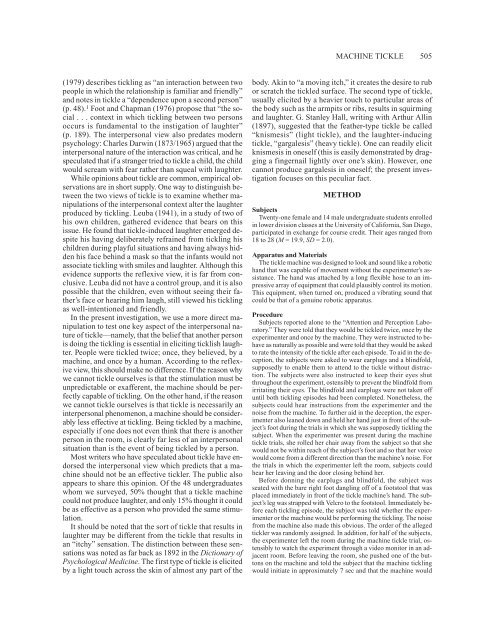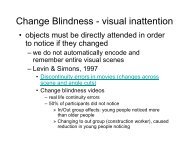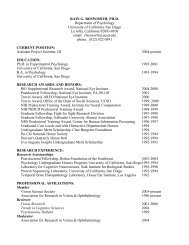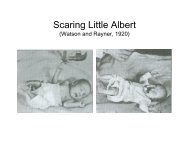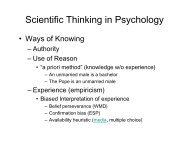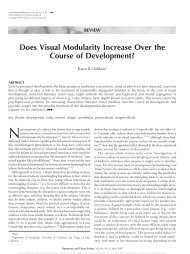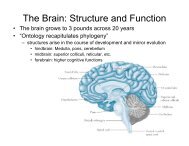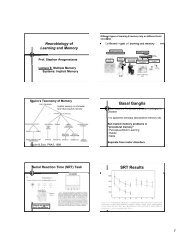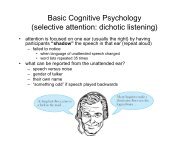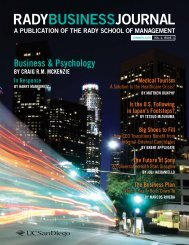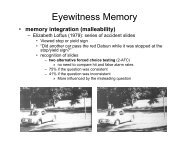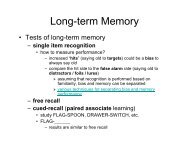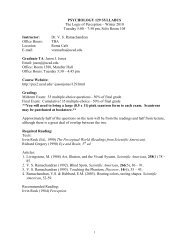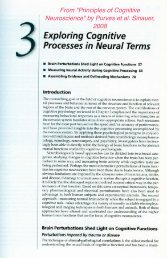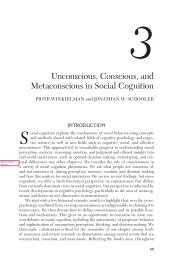Can a machine tickle?
Can a machine tickle?
Can a machine tickle?
You also want an ePaper? Increase the reach of your titles
YUMPU automatically turns print PDFs into web optimized ePapers that Google loves.
(1979) describes tickling as “an interaction between two<br />
people in which the relationship is familiar and friendly”<br />
and notes in <strong>tickle</strong> a “dependence upon a second person”<br />
(p. 48). 1 Foot and Chapman (1976) propose that “the social<br />
. . . context in which tickling between two persons<br />
occurs is fundamental to the instigation of laughter”<br />
(p. 189). The interpersonal view also predates modern<br />
psychology: Charles Darwin (1873/1965) argued that the<br />
interpersonal nature of the interaction was critical, and he<br />
speculated that if a stranger tried to <strong>tickle</strong> a child, the child<br />
would scream with fear rather than squeal with laughter.<br />
While opinions about <strong>tickle</strong> are common, empirical observations<br />
are in short supply. One way to distinguish between<br />
the two views of <strong>tickle</strong> is to examine whether manipulations<br />
of the interpersonal context alter the laughter<br />
produced by tickling. Leuba (1941), in a study of two of<br />
his own children, gathered evidence that bears on this<br />
issue. He found that <strong>tickle</strong>-induced laughter emerged despite<br />
his having deliberately refrained from tickling his<br />
children during playful situations and having always hidden<br />
his face behind a mask so that the infants would not<br />
associate tickling with smiles and laughter. Although this<br />
evidence supports the reflexive view, it is far from conclusive.<br />
Leuba did not have a control group, and it is also<br />
possible that the children, even without seeing their father’s<br />
face or hearing him laugh, still viewed his tickling<br />
as well-intentioned and friendly.<br />
In the present investigation, we use a more direct manipulation<br />
to test one key aspect of the interpersonal nature<br />
of <strong>tickle</strong>—namely, that the belief that another person<br />
is doing the tickling is essential in eliciting ticklish laughter.<br />
People were <strong>tickle</strong>d twice; once, they believed, by a<br />
<strong>machine</strong>, and once by a human. According to the reflexive<br />
view, this should make no difference. If the reason why<br />
we cannot <strong>tickle</strong> ourselves is that the stimulation must be<br />
unpredictable or exafferent, the <strong>machine</strong> should be perfectly<br />
capable of tickling. On the other hand, if the reason<br />
we cannot <strong>tickle</strong> ourselves is that <strong>tickle</strong> is necessarily an<br />
interpersonal phenomenon, a <strong>machine</strong> should be considerably<br />
less effective at tickling. Being <strong>tickle</strong>d by a <strong>machine</strong>,<br />
especially if one does not even think that there is another<br />
person in the room, is clearly far less of an interpersonal<br />
situation than is the event of being <strong>tickle</strong>d by a person.<br />
Most writers who have speculated about <strong>tickle</strong> have endorsed<br />
the interpersonal view which predicts that a <strong>machine</strong><br />
should not be an effective <strong>tickle</strong>r. The public also<br />
appears to share this opinion. Of the 48 undergraduates<br />
whom we surveyed, 50% thought that a <strong>tickle</strong> <strong>machine</strong><br />
could not produce laughter, and only 15% thought it could<br />
be as effective as a person who provided the same stimulation.<br />
It should be noted that the sort of <strong>tickle</strong> that results in<br />
laughter may be different from the <strong>tickle</strong> that results in<br />
an “itchy” sensation. The distinction between these sensations<br />
was noted as far back as 1892 in the Dictionary of<br />
Psychological Medicine. The first type of <strong>tickle</strong> is elicited<br />
by a light touch across the skin of almost any part of the<br />
MACHINE TICKLE 505<br />
body. Akin to “a moving itch,” it creates the desire to rub<br />
or scratch the <strong>tickle</strong>d surface. The second type of <strong>tickle</strong>,<br />
usually elicited by a heavier touch to particular areas of<br />
the body such as the armpits or ribs, results in squirming<br />
and laughter. G. Stanley Hall, writing with Arthur Allin<br />
(1897), suggested that the feather-type <strong>tickle</strong> be called<br />
“knismesis” (light <strong>tickle</strong>), and the laughter-inducing<br />
<strong>tickle</strong>, “gargalesis” (heavy <strong>tickle</strong>). One can readily elicit<br />
knismesis in oneself (this is easily demonstrated by dragging<br />
a fingernail lightly over one’s skin). However, one<br />
cannot produce gargalesis in oneself; the present investigation<br />
focuses on this peculiar fact.<br />
METHOD<br />
Subjects<br />
Twenty-one female and 14 male undergraduate students enrolled<br />
in lower division classes at the University of California, San Diego,<br />
participated in exchange for course credit. Their ages ranged from<br />
18 to 28 (M = 19.9, SD = 2.0).<br />
Apparatus and Materials<br />
The <strong>tickle</strong> <strong>machine</strong> was designed to look and sound like a robotic<br />
hand that was capable of movement without the experimenter’s assistance.<br />
The hand was attached by a long flexible hose to an impressive<br />
array of equipment that could plausibly control its motion.<br />
This equipment, when turned on, produced a vibrating sound that<br />
could be that of a genuine robotic apparatus.<br />
Procedure<br />
Subjects reported alone to the “Attention and Perception Laboratory.”<br />
They were told that they would be <strong>tickle</strong>d twice, once by the<br />
experimenter and once by the <strong>machine</strong>. They were instructed to behave<br />
as naturally as possible and were told that they would be asked<br />
to rate the intensity of the <strong>tickle</strong> after each episode. To aid in the deception,<br />
the subjects were asked to wear earplugs and a blindfold,<br />
supposedly to enable them to attend to the <strong>tickle</strong> without distraction.<br />
The subjects were also instructed to keep their eyes shut<br />
throughout the experiment, ostensibly to prevent the blindfold from<br />
irritating their eyes. The blindfold and earplugs were not taken off<br />
until both tickling episodes had been completed. Nonetheless, the<br />
subjects could hear instructions from the experimenter and the<br />
noise from the <strong>machine</strong>. To further aid in the deception, the experimenter<br />
also leaned down and held her hand just in front of the subject’s<br />
foot during the trials in which she was supposedly tickling the<br />
subject. When the experimenter was present during the <strong>machine</strong><br />
<strong>tickle</strong> trials, she rolled her chair away from the subject so that she<br />
would not be within reach of the subject’s foot and so that her voice<br />
would come from a different direction than the <strong>machine</strong>’s noise. For<br />
the trials in which the experimenter left the room, subjects could<br />
hear her leaving and the door closing behind her.<br />
Before donning the earplugs and blindfold, the subject was<br />
seated with the bare right foot dangling off of a footstool that was<br />
placed immediately in front of the <strong>tickle</strong> <strong>machine</strong>’s hand. The subject’s<br />
leg was strapped with Velcro to the footstool. Immediately before<br />
each tickling episode, the subject was told whether the experimenter<br />
or the <strong>machine</strong> would be performing the tickling. The noise<br />
from the <strong>machine</strong> also made this obvious. The order of the alleged<br />
<strong>tickle</strong>r was randomly assigned. In addition, for half of the subjects,<br />
the experimenter left the room during the <strong>machine</strong> <strong>tickle</strong> trial, ostensibly<br />
to watch the experiment through a video monitor in an adjacent<br />
room. Before leaving the room, she pushed one of the buttons<br />
on the <strong>machine</strong> and told the subject that the <strong>machine</strong> tickling<br />
would initiate in approximately 7 sec and that the <strong>machine</strong> would


